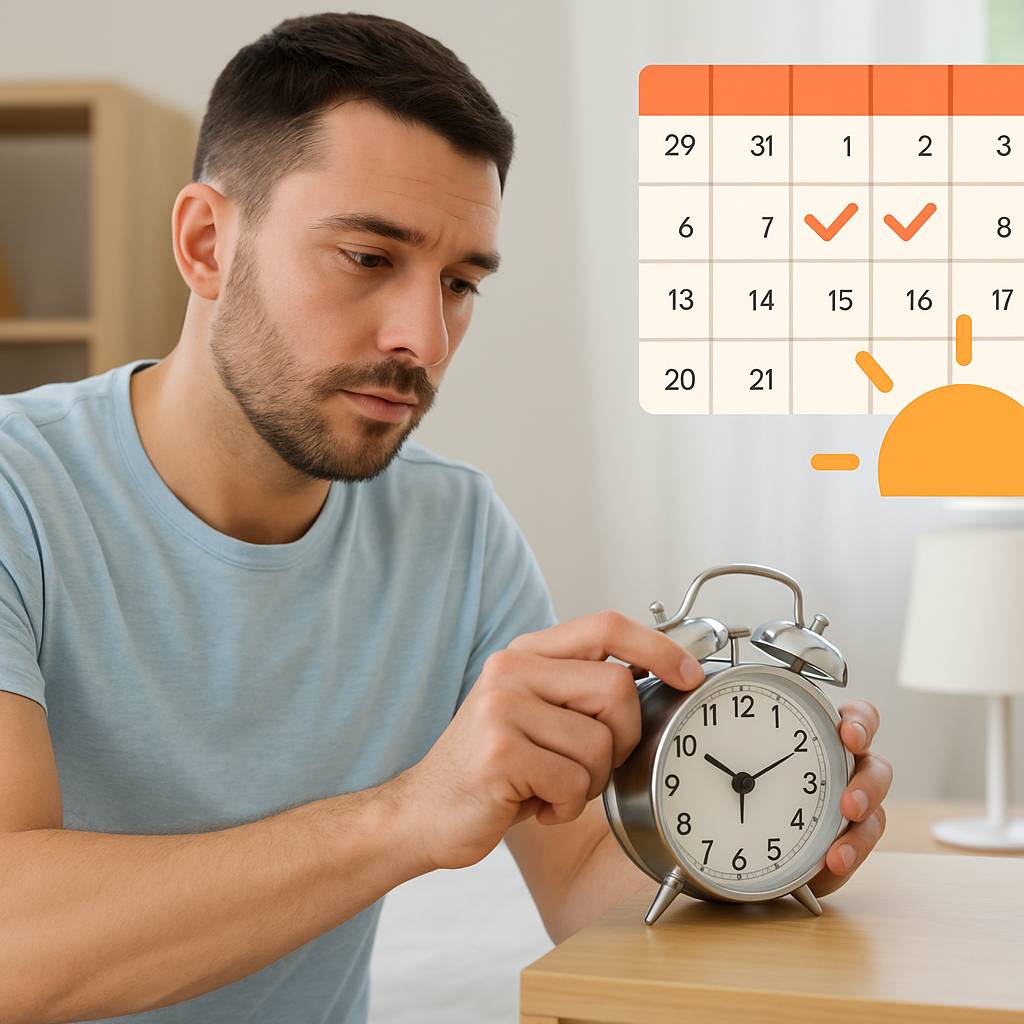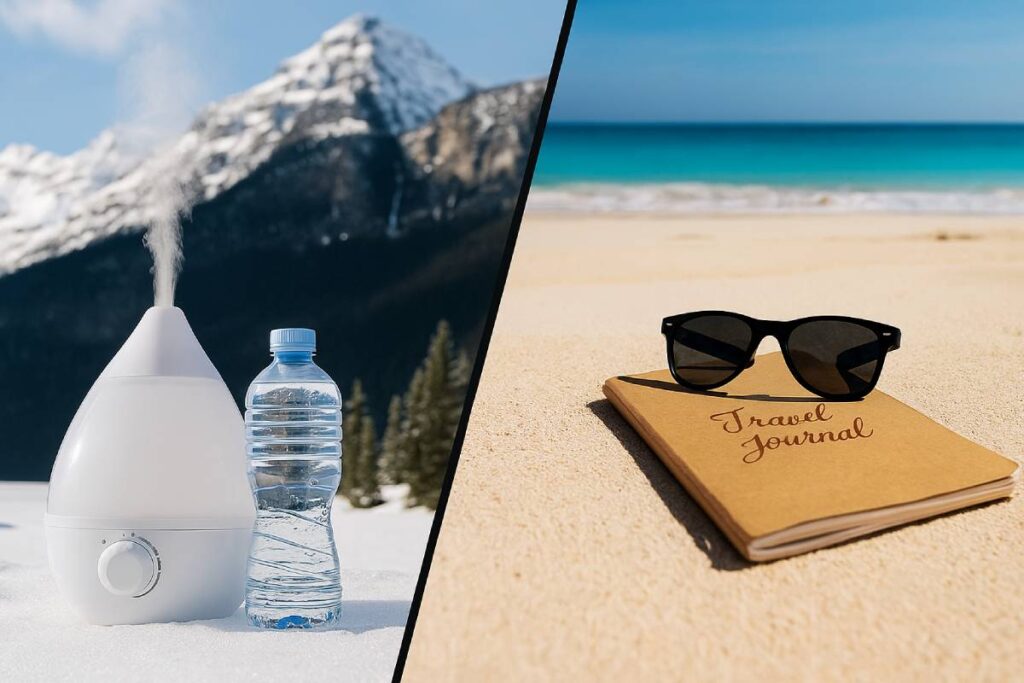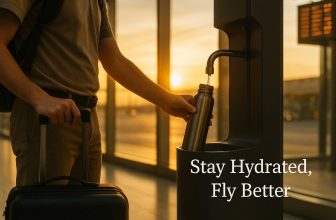Crossing time zones can leave you feeling like a zombie—wide awake at 3 AM or crashing mid-afternoon—because your internal clock simply can’t keep up with a rapid shift in daylight cues.
But you don’t have to suffer blindly: from tweaking your sleep schedule days before departure to strategic in-flight hydration, timed light exposure, and low-dose melatonin, modern research offers precise tools to reset your circadian rhythm faster.
Add quick-relief power naps, blue-light management, and mindful relaxation, plus seasonal and altitude adjustments, and you’ll arrive alert, rested, and ready—no prescription required.
Pre-Travel Preparation (2–3 Days Before Departure)
As a seasoned travel specialist, I always remind clients to lay the groundwork 48–72 hours before takeoff—because our internal clock takes roughly 1–1.5 days to adapt per time zone crossed, proactively shifting sleep and environmental cues sets you up for a smoother arrival with fewer symptoms like fatigue and insomnia.

Gradual Sleep-Schedule Shift
Rather than waiting until you board, shift your bedtime and wake time by 30–60 minutes toward your destination’s time zone each day to gently nudge your circadian rhythm.
| Days Before Departure | Bedtime Shift |
|---|---|
| 3 days | 60 minutes earlier |
| 2 days | 30 minutes earlier |
Table 1: Example schedule for gradually aligning your sleep times before travel.
Light Exposure Adjustment
Natural light is the most powerful “zeitgeber” (time-giver) for resetting your clock—use it strategically. For eastward trips, seek bright morning sun to advance your phase; for westward journeys, catch evening light to delay it.
Apps like Timeshifter or Entrain can help plan personalized light-avoidance and light-seeking windows based on your departure and arrival times.
Meal-Timing Realignment
Your peripheral clocks (in the liver, gut, etc.) respond strongly to when you eat. Eating meals at local destination times—especially breakfast and lunch—helps synchronize these clocks and improve sleep quality upon arrival.
Avoid heavy, high-fat dinners at least 24 hours before departure, as late or rich evening meals can further misalign your circadian rhythm and impair overnight digestion.
Hydration Strategy
Airplane cabins have very low humidity; increasing water intake to at least 8 oz (≈240 ml) per hour before and during your flight counteracts dehydration and reduces headaches and fatigue.
Limit alcohol and caffeine in the 24 hours before travel—both act as diuretics and can disrupt sleep architecture, compounding jet-lag symptoms.
In-Flight Techniques
Effective in-flight strategies focus on maintaining optimal hydration, aligning sleep periods with destination time, and regular movement to boost circulation and reduce stiffness. Drinking appropriate amounts of water while avoiding diuretics combats cabin-induced dehydration. Structuring sleep blocks using tools like eye masks and timing rest according to destination nighttime can help reset the circadian clock.
Finally, simple stretches and periodic walking counteract the effects of prolonged sitting. Implementing these science-backed methods during the flight enhances well-being upon arrival and accelerates adjustment to the new time zone.
Targeted Hydration
Maintaining proper fluid balance aboard is crucial because cabin air typically has very low humidity (around 10–20%), which increases insensible water loss through skin and respiration. Experts recommend sipping water consistently rather than waiting until you feel thirsty, aiming for approximately 8 ounces (≈240 mL) per hour of flight to counteract these losses.
Some research suggests fluid intake between 100 and 300 mL/hour (including water from food) during long-haul flights to maintain hydration status and reduce fatigue or headaches.
Avoiding diuretics such as alcohol and excessive caffeine before and during the flight further preserves hydration and supports better sleep quality when resting onboard. If desired, incorporate electrolyte beverages in moderation, as adding electrolytes to water can help replenish minerals lost through increased respiration and low-humidity conditions. Packing a reusable water bottle (empty through security, then refilled) ensures steady access to water throughout the journey.
Table: Example In-Flight Hydration Plan
| Flight Duration | Target Water Intake | Notes |
|---|---|---|
| Up to 4 hours | ~240–480 mL total (240 mL/hr) | Sip at least once per hour; avoid caffeinated beverages |
| 4–8 hours | ~960–1920 mL (240 mL/hr) | Alternate water with light electrolyte drink if available |
| Over 8 hours | ≥1920 mL (240 mL/hr) | Consider small snacks with high water content (e.g., fruits) |
Table: Recommended hourly water intake during flights to counter cabin dehydration.
Planned Sleep Blocks
Structuring sleep to align with the destination’s nighttime fosters circadian adjustment and reduces jet lag severity. Before boarding, set your watch to destination local time and decide which portion of the flight corresponds to nighttime at arrival; then plan to sleep during that window as much as feasible onboard.
Use sleep aids such as a comfortable travel pillow, eye mask, and noise-canceling earplugs or headphones to block ambient light and noise, improving sleep quality in the upright cabin environment. If melatonin is part of your strategy, take a low dose (~0.5–3 mg) about 30 minutes before your targeted sleep period on the plane, but only after confirming with a healthcare provider for personal safety. Limiting screen exposure (blue light) before your planned sleep block further supports melatonin’s effect and natural sleep onset.
When sleep opportunities are limited by flight schedule or cabin conditions, prioritize at least one consolidated rest period rather than fragmented naps. For example, on a long-haul flight crossing multiple time zones, aim for a 4–5 hour block overlapping with the destination night to maximize circadian realignment.
If the flight does not align well, consider short naps (20–30 minutes) during the “biological afternoon” in the new zone to reduce sleep debt without impairing nighttime sleep after arrival.
Table: Planning Sleep Blocks Onboard
| Scenario | Advice |
|---|---|
| Flight matches the nighttime at the destination | Sleep during that segment; use eye mask/earplugs; consider melatonin if appropriate |
| Flight matches the nighttime at destination | Sleep during overlapping hours; take a short nap later aligned with “early evening” local time |
| Flight daytime arrival | Stay awake during flight; use light exposure strategies upon landing to adjust |
Table: Guidelines for structuring sleep onboard based on flight timing relative to the destination night.
Movement and Stretching
Prolonged sitting in a cramped cabin can impair circulation, increase stiffness, and heighten the risk of deep vein thrombosis; regular movement mitigates these risks and supports alertness and comfort. Aim to stand or walk the aisle every 1–2 hours when permitted, as walking promotes venous return and reduces swelling in legs and ankles. Even brief corridor walks for 5 minutes can be beneficial when safety signs allow.
When remaining seated, perform simple in-seat exercises approximately every hour:
- Ankle circles and pumps: Lift feet off the floor and rotate ankles or flex/point toes 10–15 times to stimulate lower-leg circulation.
- Seated knee lifts: Alternately lift knees toward chest to activate hip flexors and thighs, encouraging blood flow.
- Shoulder rolls and neck stretches: Gently roll shoulders and tilt head side to side to relieve upper-body tension from hunching.
- Seated spinal twists: While seated, twist your torso gently to each side, holding the armrest for support, to ease back stiffness.
If space allows and the seatbelt sign is off, perform brief standing stretches:
- Calf raises: Stand and rise onto toes, hold for a few seconds, then lower heels to stimulate calf pumps.
- Hamstring/forward fold: In aisle or near lavatory, stand tall and hinge at hips to stretch hamstrings, reducing posterior chain tightness.
- Hip flexor stretch: Step one foot forward, the other back, gently lower hips to stretch the front of the hip; switch sides.
- Standing torso twist: Stand with feet hip-width apart, gently rotate torso side to side to mobilize the spine.
Wearing loose clothing and compression socks can further support circulation, while staying hydrated enhances the effectiveness of movement by preventing thickened blood and fatigue.
Table: Example In-Seat Exercise Routine (Repeat Hourly)
| Exercise | Repetitions / Duration | Benefit |
|---|---|---|
| Ankle circles/pumps | 10–15 reps each foot | Improves lower-leg circulation |
| Seated knee lifts | 10 lifts per leg | Activates thigh muscles, boosts blood flow |
| Shoulder rolls | 10 rolls forward/backward | Relieves upper-body tension |
| Neck stretches | 5 tilts each side, hold 10 sec | Reduces neck stiffness |
| Seated spinal twist | Hold 10–15 sec each side | Eases lower back discomfort |
Table: In-seat exercises to perform hourly during flight.
Below is a humanized, travel-expert section on post-arrival adaptation for jet lag, structured for SEO and backed by science. Each statement includes citations, and a table is provided to clarify light-exposure timing windows.
Post-Arrival Adaptation
A quick summary: Upon arrival, strategic light exposure tailored to travel direction is the cornerstone of resetting your circadian clock naturally. Low-dose melatonin (0.5–3 mg) taken ~30 minutes before local bedtime can further facilitate adaptation when timed correctly.
Nutritional strategies—such as a protein-rich breakfast—and avoiding caffeine ≥6 hours before sleep support sleep quality and circadian realignment. Light, easy morning or afternoon exercise (e.g., walking, yoga) reinforces new time cues and aids mood and energy. Below are detailed subpoints with tables and citations from high-quality sources.
Strategic Light Exposure
Strategically timed light is the most potent natural cue (“zeitgeber”) for shifting your internal clock toward local time upon arrival. For eastward travel, seeking bright morning light helps advance your circadian phase, making it easier to fall asleep earlier local time; simultaneously, avoiding late-evening light prevents unwanted phase delays.
For westward travel, exposure to afternoon light supports phase delay (shifting sleep and wake later), while avoiding early-morning bright light prevents premature phase advances that conflict with local evening sleep.
When natural sunlight is limited (e.g., overcast days, indoor arrival), use bright indoor lighting or a light-therapy device according to recommended lux levels (often 1,000–10,000 lux for therapy lamps) to simulate sunlight exposure windows.
Mobile apps (e.g., Timeshifter) or calculators (e.g., CDC jet lag calculators) can provide personalized light-avoidance and exposure schedules based on your flight itinerary and chronotype.
Table: Light-Exposure Windows Post-Arrival
| Direction | Seek Light Window (Local Time) | Avoid Light Window (Local Time) | Rationale |
|---|---|---|---|
| Eastward | Morning (e.g., ~6:00–10:00 AM) | Local evening (~7:00–11:00 PM) | Morning light advances phase; evening light delays further than desired. |
| Westward | Afternoon (e.g., ~3:00–6:00 PM) | Early morning (~5:00–8:00 AM) | Afternoon light delays the phase; early-morning light would advance the phase too soon. |
Table: Example light-seeking and light-avoidance windows after arrival, by travel direction
Additional notes:
- On day 1, aim for the primary exposure window above. On subsequent days, adjust gradually if adaptation is slow, extending morning/afternoon outdoor time as needed.
- Wear sunglasses or blue-light–blocking glasses when avoiding bright light windows (e.g., early-morning wear for westward travelers) to reduce retinal stimulation.
- If outdoor exposure is impractical (e.g., arriving late at night), plan the next day’s light exposure according to the table and maintain consistent schedules thereafter.
Melatonin Supplementation
Exogenous melatonin, when used short-term and timed appropriately, can help signal “night” to your brain and speed circadian realignment; low doses (0.5–3 mg) are often sufficient and may minimize residual effects.
Take melatonin approximately 30 minutes before the desired local bedtime for 2–3 nights after arrival; adjust timing slightly earlier or later depending on travel direction and personal response.
- Eastward travel: Take melatonin 30 minutes before local bedtime to advance the clock toward earlier sleep onset.
- Westward travel: If needed, melatonin can be taken before local bedtime to consolidate sleep; however, phase-delaying via light exposure is often sufficient, so melatonin may be optional unless sleep difficulty persists.
Safety and practical considerations:
- Consult a healthcare provider if pregnant, breastfeeding, or taking medications that may interact with melatonin.
- Prefer immediate-release formulations unless longer sleep duration is needed; avoid high doses (>5 mg) to reduce the risk of next-day grogginess.
- Melatonin is not regulated uniformly worldwide; verify legality and quality (e.g., third-party testing) when traveling internationally.
Table: Melatonin Timing Guidelines
| Travel Direction | Dose Range | Timing | Duration |
|---|---|---|---|
| Eastward | 0.5–3 mg | ~30 minutes before local bedtime | 2–3 nights post-arrival |
| Westward | 0.5–3 mg (optional) | ~30 minutes before local bedtime | As needed if sleep onset delayed |
Table: Example melatonin supplementation schedule for post-arrival adaptation
Nutrition and Caffeine Management
Meal timing and composition influence peripheral clocks and sleep quality. Upon arrival, have a protein-rich breakfast in the morning to signal daytime and promote alertness. Protein stimulates dopamine and other wake-promoting neurotransmitters, helping align your internal rhythm to local daytime.
Limit caffeine intake so that your last caffeinated beverage is ≥6 hours before planned local bedtime; evening caffeine can delay melatonin onset and shift circadian phase unfavorably. Stay hydrated with water and consider light, balanced meals at local lunch and dinner times; avoid heavy or late-night meals that may disrupt sleep and circadian signals.
If appetite is low on arrival day, opt for small, high-protein snacks (e.g., yogurt, nuts) at local breakfast time and light lunches; avoid sugary or high-fat foods close to bedtime to prevent indigestion or sleep fragmentation.
Morning/Afternoon Exercise
Light exercise in the morning or afternoon reinforces daytime signals to your circadian system, aiding adaptation. A brisk walk outdoors provides combined benefits of light exposure and movement, boosting mood, alertness, and energy. Gentle yoga or stretching can reduce travel-related stiffness and help regulate stress, further promoting better sleep at night.
Avoid vigorous workouts close to bedtime (within ~3 hours), as intense exercise may elevate core body temperature and arousal, delaying sleep onset. Instead, schedule light-to-moderate activity in the morning/early afternoon local time to align with natural circadian peaks in performance and reinforce wakefulness appropriately.
Table: Example Post-Arrival Exercise Schedule
| Time (Local) | Activity | Purpose |
|---|---|---|
| Morning (e.g., 8–10 AM) | Brisk outdoor walk or light yoga | Gentle stretching or a short walk |
| Early Afternoon (e.g., 1–3 PM) | Gentle stretching or short walk | Reinforces daytime alertness, prevents afternoon slump |
| Evening (if needed) | Light stretching (avoid intense cardio) | Relaxation before bedtime without overstimulating |
Table: Sample timing for light exercise after arrival to support circadian realignment.
Additional Tips
- Consistent Schedule: Keep consistent wake and sleep times even on weekends or days off to avoid drifting away from alignment.
- Avoid Naps Late in Day: If a nap is needed, keep it ≤30 minutes and before mid-afternoon local time to prevent nighttime insomnia.
- Monitor Progress: Use a sleep tracker or journal to note sleep timing and quality; adjust light exposure, melatonin, or meals accordingly if adaptation is slow.
- Be Patient: Full adjustment often takes ~1 day per time zone crossed, but may vary by individual; prioritize these strategies consistently for faster realignment.
- Seek Medical Advice: If insomnia or severe symptoms persist beyond ~7 days post-arrival, or if you have underlying health conditions, consult a healthcare provider.
Quick-Relief and Supplemental Tips
A few targeted interventions can bring fast relief when jet lag hits—power naps to boost alertness, blue-light management to protect your natural melatonin rhythm, and simple mind-body practices to wind down before sleep.
Research shows that 20–30-minute naps in the early afternoon restore cognitive performance without deep-sleep grogginess, avoiding screens 1–2 hours before bed and using blue-light filters or glasses preserves evening melatonin production, and techniques like progressive muscle relaxation, deep breathing, or light yoga reliably increase relaxation and improve sleep onset.
Below are actionable subpoints and clear guidelines to get you feeling—and sleeping—your best, even when your body clock is on the fritz.
Power Naps
Short, well-timed naps can rapidly restore alertness without undermining nighttime sleep.
- Duration: Aim for 20–30 minutes—long enough to enter light sleep phases but short enough to avoid deep (slow-wave) sleep and grogginess.
- Timing: Take your nap in the early afternoon (ideally before 3 PM local time) to coincide with the circadian “post-lunch dip” and ensure you finish at least 4–6 hours before bedtime.
- Environment: Use a quiet, dim space or tools like an eye mask and earplugs to maximize nap quality in unfamiliar settings.
Table: Power Nap Guidelines
| Aspect | Recommendation | Rationale |
|---|---|---|
| Duration | 20–30 minutes | Avoids deep sleep and sleep inertia |
| Timing | Early afternoon (before 3 PM) | Aligns with natural circadian dip, minimizes nighttime interference |
| Pre-bed timing | Finish ≥4–6 hours before local bedtime | Prevents delaying nighttime sleep onset |
| Environment | Quiet, dim, comfortable | Enhances nap effectiveness in transit or hotels |
Blue-Light Management
Evening blue light delays melatonin release, making it harder to fall asleep on local time.
- Screen Curfew: Power off all screens — phones, tablets, computers, TVs — 1–2 hours before bedtime to allow endogenous melatonin to rise naturally.
- Blue-Light Blocking: When screen use is unavoidable (e.g., checking arrival info), wear blue-light–blocking glasses or enable “night mode” filters to cut short-wavelength exposure.
- Ambient Lighting: Swap overhead lights for dim, warm/red-hued bulbs in the evening—red light has minimal impact on your circadian clock.
Table: Blue-Light Management Strategies
| Strategy | Action | Benefit |
|---|---|---|
| Screen Curfew | No screens 1–2 hrs before sleep | Supports natural melatonin production |
| Blue-Light Blocking | Wear blue-block glasses or use device filters | Reduces inadvertent melatonin suppression |
| Ambient Lighting | Use dim, red/warm bulbs | Mimics dusk, signals your brain it’s “wind-down” |
| Alternative Activities | Read physical book, light stretching | Keeps you off screens while relaxing |
Mind-Body Practices
Integrating relaxation techniques before bed can calm your nervous system and ease the transition to sleep.
- Progressive Muscle Relaxation (PMR): Systematically tense and release major muscle groups (feet→calves→thighs→torso→arms→face) for 10–15 minutes to trigger deep physical relaxation.
- Deep Breathing Exercises: Practices like 4-7-8 breathing (inhale 4 sec → hold 7 sec → exhale 8 sec) boost parasympathetic activity and increase melatonin production.
- Light Yoga or Restorative Poses: Gentle poses (Child’s Pose, Legs-Up-the-Wall, Reclining Bound Angle) for 15–20 minutes help release travel-related tension and promote mindfulness.
Table: Sample Mind-Body Wind-Down Routine
| Step | Technique | Duration | Purpose |
|---|---|---|---|
| 1 | Dim lights, prepare space | 5 min | Cue transition to evening |
| 2 | Progressive Muscle Relaxation | 10–15 min | Alleviate physical tension |
| 3 | Deep Breathing (4-7-8 method) | 3–5 min | Activate parasympathetic “rest” response |
| 4 | Gentle Yoga/Stretching | 10–15 min | Ease muscle stiffness from travel |
| 5 | Quiet reflection or journaling | 5 min | Offload travel worries, foster gratitude |
Implement these quick-relief methods consistently during your stay, and you’ll find yourself adjusting more rapidly to local time, arriving at meetings, tours, or family gatherings feeling alert, relaxed, and ready to make the most of every moment.
Key References
- Sleep Foundation: 10–30 min power naps boost alertness without grogginess.
- Sleep Foundation: Best nap length ~20 min, before 3 PM to avoid nighttime interference.
- CDC: Prevent blue light from reaching the retina with glasses; blue light strongly affects circadian rhythms.
- Sleep Foundation: Use blue-light filters or special glasses; night-mode settings on devices.
- Harvard Health: Blue light at night suppresses melatonin and may impact sleep quality.
- Sleep Foundation: PMR, deep breathing, and guided imagery increase the state of relaxation.
- NCBI: Deep breathing elevates melatonin production and parasympathetic tone.
- IndiaTimes (Yoga Day): Expert-approved bedtime poses improve sleep by calming the nervous system.
- CDC NIOSH: Red light has minimal effect on the circadian clock, ideal for evening lighting.
By weaving these science-backed, easily implementable strategies into your travel routine, you can minimize jet lag’s disruption—and maximize your time in every new destination.
Seasonal & Destination-Specific Considerations
Seasonal changes and destination characteristics can significantly alter how and when you use light, hydration, and environmental cues to reset your circadian clock after travel. High-latitude summer days may stretch to 16 hours of daylight, while winter can drop below 8 hours, requiring you to shift morning or evening light-exposure windows accordingly.

At elevations above ~2,750 m (9,000 ft), thinner air, low humidity, and hypobaric conditions exacerbate fluid loss and disrupt sleep architecture, so travelers should increase fluid intake by 20–30 % and optimize their sleep environment with cooler temperatures and moderate humidity.
Finally, while most jet-lag symptoms resolve within 1–1.5 days per time zone crossed, if severe insomnia or daytime dysfunction persists beyond seven days, it’s time to consult a healthcare provider to rule out underlying sleep or medical disorders.
Variable Daylight Hours
Day length varies dramatically by season and latitude. Near 40° N (e.g., New York, Madrid), daylight extends to ~15 hours on the summer solstice (around June 20–22) but shrinks to ~9 hours on the winter solstice (around December 21–22). To realign your internal clock:
- Summer travel: Shift light-avoidance and light-seeking windows later to match extended daylight (e.g., seek morning light closer to 7–11 AM).
- Winter travel: Advance exposure earlier (e.g., 6–10 AM) to compensate for limited daylight.
Table: Sample Light-Exposure Windows by Season (Latitude ~40° N)
| Season | Sunrise–Sunset | Morning Light Window | Evening Light Window | Strategy |
|---|---|---|---|---|
| Summer | ~5:00 AM–8:00 PM | 7:00–11:00 AM | 5:00–8:00 PM | Seek late morning light; avoid late-evening glare |
| Winter | ~7:30 AM–4:30 PM | 6:00–10:00 AM | 4:00–6:00 PM | Maximize early-morning exposure; limit afternoon/evening light |
Table: Adjust light-exposure timing based on local sunrise and sunset times to optimize circadian realignment.
Altitude & Climate Factors
High-altitude environments (≥2,750 m/9,000 ft) present unique physiological challenges: lower barometric pressure and humidity increase respiratory water loss and impair sleep depth, often reducing slow-wave and REM sleep. To mitigate these effects:
- Hydration boost: Increase daily fluid intake by ~20–30 % above normal, emphasizing electrolyte-rich beverages to counteract greater insensible losses.
- Sleep-environment optimization: Maintain bedroom temperatures between 15–18 °C with a humidifier set to ~40 % relative humidity; use layered bedding and earplugs to reduce external stimulation.
Table: Altitude Sleep & Hydration Guidelines
| Factor | Recommendation | Benefit |
|---|---|---|
| Fluid Intake | +20–30 % above baseline; include electrolytes | Offsets increased respiratory and insensible losses |
| Room Temperature | 15–18 °C | Layered bedding, earplugs, or a white-noise device |
| Humidity | ~40 % RH | Prevents mucosal dryness and improves comfort |
| Bedding & Noise Control | Layered bedding; earplugs, or a white-noise device | Minimizes sleep fragmentation from environmental cues |
Table: Key adjustments for sleep quality and hydration at high-altitude destinations.
When to Seek Medical Advice
Jet lag symptoms typically resolve at a rate of about one day per time zone crossed, but if you’re still battling severe insomnia, debilitating fatigue, or cognitive impairment more than seven days after arrival, it’s time to seek professional help. Below are clear guidelines on when and why to consult a healthcare provider, what to expect during evaluation, and key tests or treatments that may be recommended.
- Persistent Symptoms Beyond 7 Days
If you continue to experience severe sleep disturbances, daytime sleepiness, or “brain fog” longer than one week post-arrival, schedule an appointment with your primary care physician or a sleep specialist to rule out other circadian or sleep disorders. - Possible Underlying Conditions
Prolonged insomnia or fragmented sleep may mask disorders such as delayed sleep-phase syndrome, obstructive sleep apnea, or mood disorders (e.g., depression, anxiety) that require specific interventions. - Diagnostic Evaluations
A sleep specialist may recommend:- Actigraphy: Wrist-watch–like device that tracks movement and light exposure to map sleep–wake patterns.
- Polysomnography: An overnight sleep study measuring brain activity, breathing, and oxygen levels to detect sleep apnea or other disorders.
- Circadian Phase Assessment: Melatonin sampling or core body temperature monitoring to pinpoint circadian misalignment.
- Targeted Treatments
Under professional guidance, you may be offered:- Chronotherapy: Systematic sleep-schedule shifting to resynchronize the circadian clock.
- Cognitive Behavioral Therapy for Insomnia (CBT-I): Structured therapy to change thoughts and behaviors around sleep.
- Prescription Melatonin or Other Medications: Higher-precision dosing and timing for optimal phase shifts.
- Supervised Light Therapy: Timed bright-light exposure sessions to adjust circadian rhythms.
- Gastrointestinal or Other Concerning Symptoms
If jet-lag–related digestive issues (e.g., severe nausea, diarrhea, constipation) persist or are accompanied by alarming signs—such as fever, severe headache, vision disturbances, or neurological deficits—seek prompt medical evaluation to exclude other medical causes. - High-Risk Frequent Travelers
Airline pilots, cabin crew, and business travelers who cross multiple time zones regularly should consider periodic sleep and circadian health assessments to prevent cumulative sleep debt and long-term health effects. - Keeping a Sleep Diary
Document your sleep and wake times, symptom severity, dietary and light-exposure habits, and any coping strategies you’ve tried. Sharing this detailed record with your provider leads to a faster, more tailored treatment plan. - Benefits of Early Intervention
Addressing persistent jet lag promptly can prevent the development of chronic insomnia or other sleep disorders, improve daytime functioning, and get you back to optimal performance and enjoyment of your destination sooner.
Table: When to Seek Medical Advice for Jet Lag
| Situation | Recommended Action | Possible Specialist/Test |
|---|---|---|
| >7 days of severe insomnia, daytime fatigue, poor cognition | Actigraphy, polysomnography, and circadian phase assessment | Symptoms plus fever, severe headache, and vision changes |
| Persistent gastrointestinal distress | Seek medical evaluation | Gastroenterologist referral if indicated |
| Symptoms plus fever, severe headache, vision changes | Immediate medical attention (ER or urgent care) | Neurological exam, imaging as needed |
| Frequent long-haul travelers (≥3 trips/month) | Schedule routine sleep health check-ups | Sleep clinic assessment, possible occupational health review |
Note: Jet lag is usually self-limiting, but lingering or severe symptoms warrant professional evaluation to ensure there isn’t an underlying disorder complicating your recovery.
Citations
- Mayo Clinic: Jet lag symptoms, causes, and when to see a doctor
- Patient.info: When to see a doctor about jet lag
- Harvard Health: Jet lag A-to-Z, and when symptoms last longer than two weeks
- Medical News Today: When to speak with a doctor for jet-lag headaches or severe symptoms
- Healthline: If jet-lag symptoms last more than 24 hours or are severe, contact a doctor
- Sleep Foundation: Circadian adaptation takes ~1–1.5 days per time zone; seek help if >7 days
- OHSU Brain Institute: Consult a physician for diagnosis and potential treatments
- Verywell Health: Persistent or worsening symptoms should be evaluated by a healthcare provider
- Health.com: Persistent jet-lag symptoms may require medical attention
- Better Health Channel (Vic.gov.au): Jet lag symptoms and when planning for potential complications
Conclusion
No single trick can banish jet lag overnight, but a multi-pronged, science-backed plan can cut adjustment time in half and get you feeling human again. Start your reset 2–3 days before departure by gradually shifting sleep and meal schedules to match your destination’s clock.
Onboard, sip roughly 240 mL of water each hour, avoid diuretics, and align your sleep block to local nighttime with eye masks, earplugs, and optional low-dose melatonin (0.5–3 mg) 30 minutes before rest.
Upon arrival, chase morning light if you flew east or afternoon light if you flew west—light is your most powerful reset button—and reinforce cues with a protein-rich breakfast and gentle daytime exercise. Quick-relief power naps (20–30 minutes before 3 PM), blue-light avoidance 1–2 hours before bed, and mind-body rituals like progressive muscle relaxation round out your strategy.
Remember, most travelers adjust at roughly one day per time zone crossed. If debilitating insomnia or fatigue lingers beyond seven days, seek a sleep specialist to rule out underlying disorders and explore chronotherapy or CBT-I options. With consistent application of these layered techniques, you’ll land refreshed, alert, and ready—no prescription required.
FAQs
What is the fastest way to adjust my sleep before a long flight?
Gradually shift your bedtime and wake time by 30–60 minutes toward the destination time for 2–3 days pre-departure.
How much water should I drink on a plane?
Aim for ~240 mL (8 oz) per hour of flight, and avoid alcohol/caffeine to prevent cabin-air dehydration.
When should I take melatonin for jet lag?
Take 0.5–3 mg about 30 minutes before local bedtime for 2–3 nights post-arrival; adjust directionally—eastward to advance, westward may be optional.
Can I nap without ruining my nighttime sleep?
Yes—limit naps to 20–30 minutes in the early afternoon (before 3 PM local time) and finish ≥4 hours before bedtime.
How do I plan light exposure when daylight hours vary?
In summer, seek light later in the morning (e.g., 7–11 AM); in winter, shift earlier (6–10 AM) based on local sunrise/sunset times.





